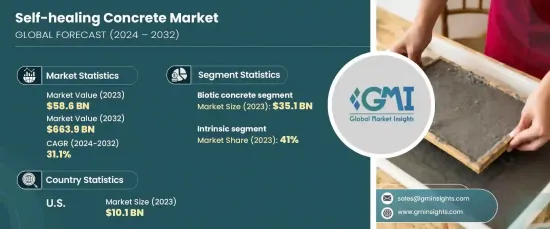
세계의 자가치유 콘크리트 시장은 2024년에 586억 달러에 이르렀으며, 2025년부터 2034년까지 CAGR은 31.1%로 눈부신 성장이 예측됩니다.
공급망 중단, 노동력 부족, 건설 지연과 같은 초기 문제로 인해 추진력이 둔화되었지만, 업계의 강력한 회복과 혁신에 대한 집중으로 성장 궤도에 활력을 불어넣고 있습니다.

지속 가능하고 내구성 있는 건설 관행에 대한 강조가 커지면서 자가치유 콘크리트에 대한 수요가 증가하고 있습니다. 균열 및 구조적 열화와 같은 일반적인 문제를 해결함으로써 이 첨단 소재는 인프라 수명을 연장할 뿐만 아니라 유지보수 비용도 절감합니다. 전 세계적으로 친환경 솔루션과 탄력적인 인프라가 각광받으면서 자가치유 콘크리트는 현대 건설 프로젝트의 초석이 되었습니다.
| 시장 범위 | |
|---|---|
| 시작 연도 | 2023년 |
| 예측 연도 | 2024-2032년 |
| 시작 금액 | 586억 달러 |
| 예측 금액 | 6,639억 달러 |
| CAGR | 31.1% |
시장은 콘크리트 유형에 따라 생물학적 변종과 비생물학적 변종으로 세분화됩니다. 2024년 바이오틱 콘크리트 부문은 351억 달러를 차지하며 시장을 주도했으며 2034년까지 30.6%의 CAGR로 성장할 것으로 예상됩니다. 생물학적 성분이 풍부한 바이오틱 콘크리트는 환경적 이점으로 인해 주목을 받고 있습니다. 이 혁신적인 소재는 자가치유 기능과 개선된 공기질을 제공함으로써 친환경 건축 노력과 지속 가능성 목표를 지원합니다. 도시 인프라와 환경을 고려한 건축 프로젝트에 채택되면서 그 중요성이 커지고 있습니다.
이 시장은 또한 형태별로 내재형, 캡슐형, 혈관형 자가치유 콘크리트로 세분화됩니다. 2024년 시장 점유율의 41%를 차지한 내재형 부문은 2025년부터 2034년까지 31.7%의 높은 연평균 성장률(CAGR)로 성장할 것으로 예상됩니다. 외부 개입 없이 미세 균열을 자연적으로 치유하는 능력으로 잘 알려진 내재형 콘크리트는 내구성과 비용 절감 효과로 높은 평가를 받고 있습니다.
반면에 혈관 부문은 표적화되고 효율적인 균열 복구 솔루션을 제공하는 능력에 힘입어 30.7%의 연평균 성장률로 성장하여 특수 응용 분야에 대한 매력을 더욱 강화할 것으로 예상됩니다.
미국의 자가치유 콘크리트 시장은 2024년 101억 달러 규모였으며 2034년까지 31%의 연평균 성장률로 크게 성장할 것으로 예상됩니다. 연방 및 주 정부의 인프라 투자가 급증한 것이 주요 성장 요인으로 작용했습니다. 도로, 교량, 상수도 시스템을 현대화하는 데 상당한 자금이 투입되면서 자가치유 콘크리트와 같은 첨단 소재에 대한 강력한 수요가 창출되고 있습니다. 내구성과 비용 효율성, 환경적 이점을 제공하는 콘크리트는 노후화된 인프라를 혁신하는 데 이상적인 선택입니다.
The Global Self-Healing Concrete Market reached an impressive valuation of USD 58.6 billion in 2024 and is set to soar at a remarkable CAGR of 31.1% between 2025 and 2034. Although initial challenges such as supply chain disruptions, labor shortages, and construction delays slowed momentum, the industry's strong recovery and a focus on innovation have revitalized its growth trajectory.

The growing emphasis on sustainable and durable construction practices is a driving force behind the rising demand for self-healing concrete. By addressing common problems such as cracks and structural degradation, this advanced material not only extends infrastructure lifespans but also reduces maintenance costs. As eco-friendly solutions and resilient infrastructure take center stage globally, self-healing concrete has become a cornerstone of modern construction projects.
| Market Scope | |
|---|---|
| Start Year | 2023 |
| Forecast Year | 2024-2032 |
| Start Value | $58.6 Billion |
| Forecast Value | $663.9 Billion |
| CAGR | 31.1% |
The market is segmented by concrete type into biotic and abiotic variants. In 2024, the biotic concrete segment led the market, accounting for USD 35.1 billion, and is projected to grow at a CAGR of 30.6% through 2034. Biotic concrete, enriched with biological agents, is gaining traction due to its environmental benefits. This innovative material supports green building initiatives and sustainability goals by offering self-healing capabilities and improved air quality. Its adoption in urban infrastructure and eco-conscious architectural projects underscores its growing significance.
The market is further categorized by form into intrinsic, capsule-based, and vascular self-healing concrete. The intrinsic segment, comprising 41% of the market share in 2024, is anticipated to grow at a robust CAGR of 31.7% between 2025 and 2034. Known for its ability to naturally heal micro-cracks without external intervention, intrinsic concrete is prized for its durability and cost-saving benefits.
The vascular segment, on the other hand, is expected to grow at a CAGR of 30.7%, driven by its ability to deliver targeted, efficient crack repair solutions, further enhancing its appeal for specialized applications.
In the United States, the self-healing concrete market was valued at USD 10.1 billion in 2024 and is set for significant growth at a CAGR of 31% through 2034. The surge in federal and state infrastructure investments has been a key growth factor. Substantial funding is being allocated to modernizing roads, bridges, and water systems, creating a robust demand for advanced materials like self-healing concrete. Its promise of durability, cost efficiency, and environmental benefits makes it an ideal choice for transforming aging infrastructure.